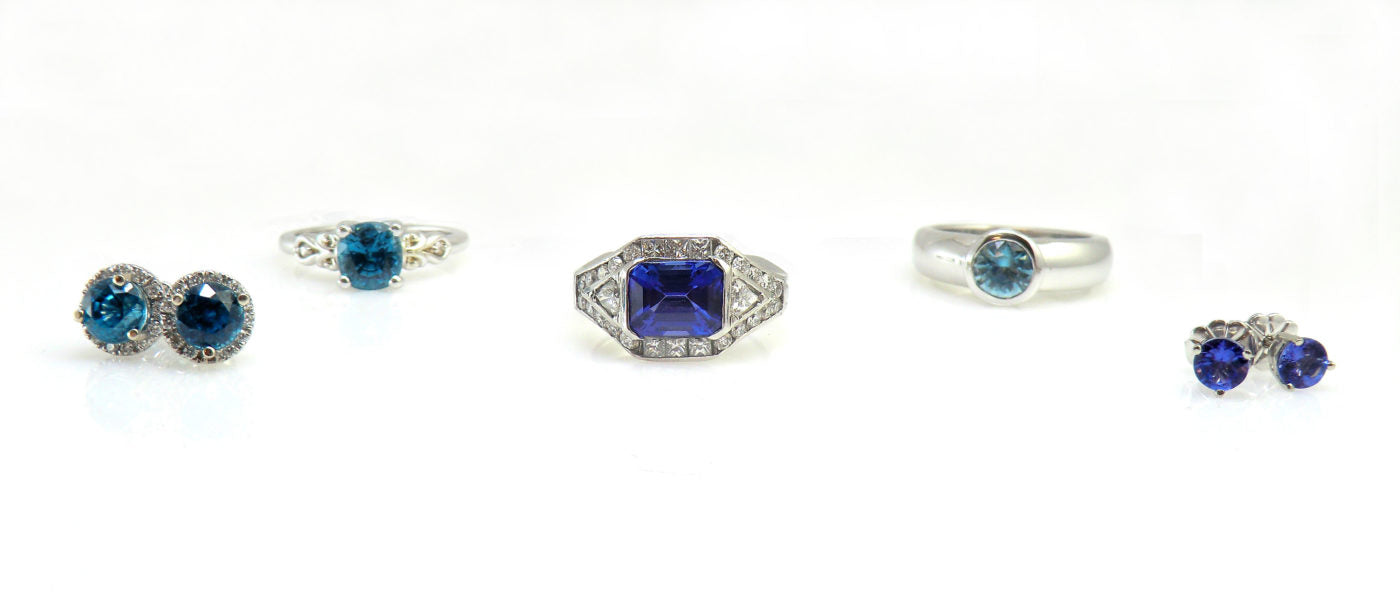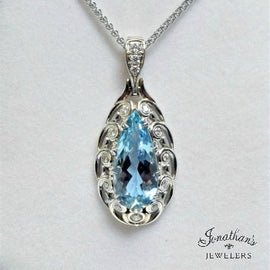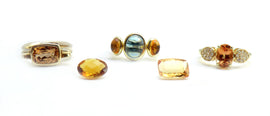If your favorite color is blue, and your birth month is December, then you’re in luck! There are three gemstones which represent December. The three stones are Turquoise, Zircon, and Tanzanite. Read on for more information about each stone’s characteristics, color options and lore.
Turquoise
Turquoise is known to be the world’s most ancient gemstones. Its name means “Turkish Stone.” Turquoise was brought to Europe on a trade route from Turkey. The blue colored stone was adorned by ancient Pharaohs of Egypt, including King Tut, as early as 5500 BC and artisans from China carved it over 3,000 years ago. Turquoise is the national gem of Tibet.
Turquoise measures as a 5 to 6 on the Mohs hardness scale. The treasured color of Turquoise is a “robin egg” blue color, with little to no matrix. Matrix is simply brown, dark gray or black blotches or veins made up of other minerals from the host rock which run through the gemstone. Typically, turquoise will be translucent to opaque with a color range of light to medium blue or greenish-blue. “Spiderweb” turquoise is found in the variety with fine web-like “seams of matrix” which creates an attractive pattern.
Most turquoise gemstones are cut into cabochons, beads, in-lays or even carved. Turquoise is a porous stone and often soaked with an artificial resin to improve its color, while adding some hardness to the surface of the stone. The best care for a turquoise gemstone is to clean in warm, gentle soapy water. Harsh chemicals will slowly dissolve the turquoise.
Looking back into the history of Turquoise, there are many interesting beliefs revolving around this gemstone, from all over the world. Turquoise, for thousands of years, has been believed to guarantee good fortune, health, and protect from evil. Believers back in the 13th century said turquoise would protect the wearer from falling (particularly from a horse) and would “break in several pieces at the approach of disaster.” Hindu spiritualists claimed that one seeing a turquoise after “beholding the new moon ensured fantastic wealth.” Here in the United States, turquoise is popular in the southwest and many Native American tribes had their own beliefs. A belief exists with Native Americans that when a turquoise is attached to a bow or firearm, one’s aim would achieve improved accuracy. Pueblos say Turquoise got its color from the sky and the Hopi tribe believed turquoise was produced by lizards roaming the earth.
Zircon
Zircon is the more common December birthstone. It is a natural gem that measures 6 to 7 ½ on the Mohs hardness scale. The name zircon is believed to derive from an Arabic word, “zarkan”, meaning “cinnabar” or “vermilion.” Some say its name derives from the Persian word “zargun” meaning “gold colored.” The color range in zircons can make either option a possibility.
The most common color of zircon is a distinctive greenish-blue. Other colors are available, like green, yellow, orange, red, brown, and even purple. These other color options are typically a muted color, and less popular. In the early 1900s, colorless zircon would be used to simulate a diamond. It should be noted that “cubic zirconia” is not a zircon. It’s a simulated man-made diamond.
Zircon is considered to be more brittle than other gemstones, especially if it is heat-treated. This means facet junctions on the stone or the girdle can become abraded, scratched or chipped from knocks or rough wear. Zircons set into pendants or earrings will limit this wear. If a zircon is set into a ring, a protected setting style is recommended, like a bezel.
Zircons are fashioned in fancy cuts, but mostly the colorless and popular blue zircon will be finished with what is called a “zircon cut”. The zircon cut is a round brilliant cut (57 facets) with an additional eight facets near the culet. Zircon is one of the fewest colored gemstones that show visible dispersion of light. A well cut zircon will show flashes of rainbow-colored fire. A zircons’ “sparkle” is a characteristic to behold and take in as its added charm.
Zircon folklore begins in the Middle Ages. This magical gem was believed to “induce sound sleep,” deter evil spirits, and bring one “riches, honor and wisdom.”
Tanzanite
Tanzanite is a newcomer to the gem world of jewelry. Discovered in Tanzania in 1962, it was introduced to the jewelry market by New York’s jeweler, Tiffany & Company. Tiffany named the gem after the country from which it was derived. Popularity of this new found gem grew instantly with the help of Tiffany’s campaigns to promote such a fine gemstone in 1968.
Tanzanite is part of the Zoisite species of gems. Tanzanite measures 6 to 7 on the Mohs hardness scale. It is a gemstone that should be worn with care. Tanzanite is sensitive to “thermal shock” (extreme temperature change in little time). It is recommended to wear tanzanite in pieces of jewelry with less exposure to accidental bumps, like earrings or pendants. Just like zircon, if worn in rings, it’s best to have the tanzanite set in a protective setting.
Tanzanite have the characteristic of “pleochroism”. Pleochroism gives a stone to have the ability to display different colors from different directions. For example, tanzanite usually looks violet-ish blue from one direction and purplish from other directions. The color of tanzanite can range from light to dark violet-ish blue, bluish purple, and even blue. Tanzanite that is bluer in color is worth more per carat. Achieving the most desired color in a tanzanite’s finished look, begins with the size of the rough, and the cutting process, due to a tanzanite crystal structure.
Since tanzanite is relatively new to the known gemstone world, there is not much on ancient folklore. Tanzanite discovery all began with a lightning strike in Tanzania. The strike caused a major wildfire, leaving behind bare lands. Locals walked the land to investigate and noticed the ground was littered with blue crystals. The heat of the wildfire transformed the brown crystals to blue. The newly discovered crystals stumped gemologist. They were not blue sapphires. It took the gemologists of the British Museum and Harvard University to confirm this was a new variety. The unknown gemstones were named “blue zoisite”. Tiffany and Co. renamed the “blue zoisite” to Tanzanite, after the country it originated in.
References:
Gemological Institute of America
Gemstones of the World, by Walter Schumann
American Gem Trade Association



